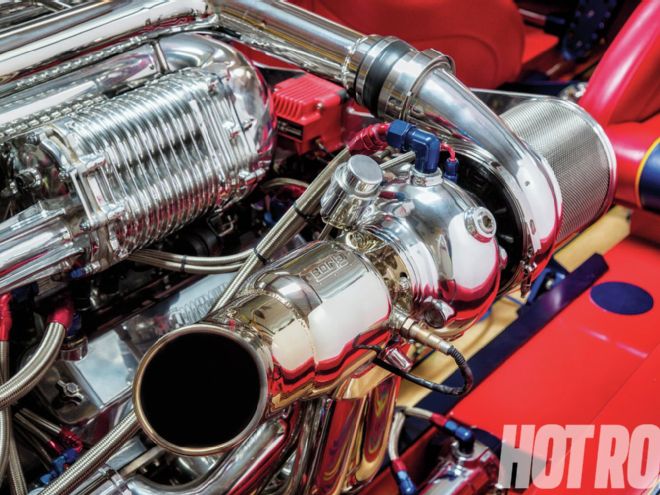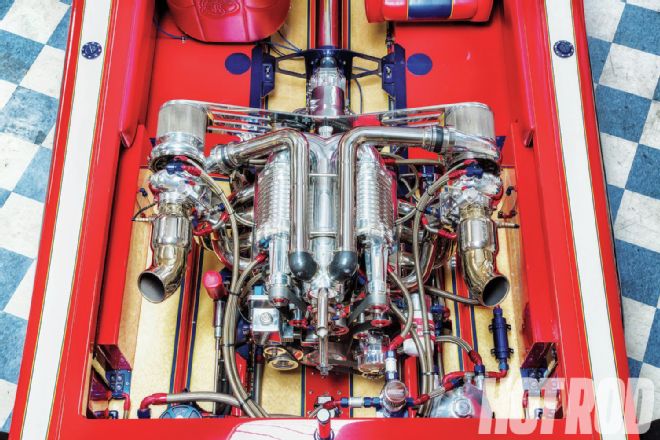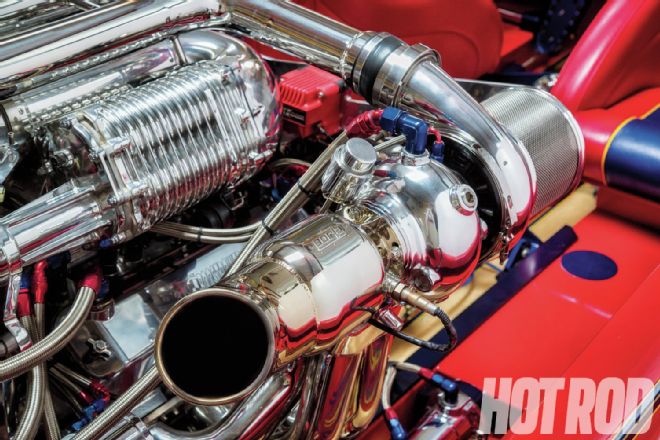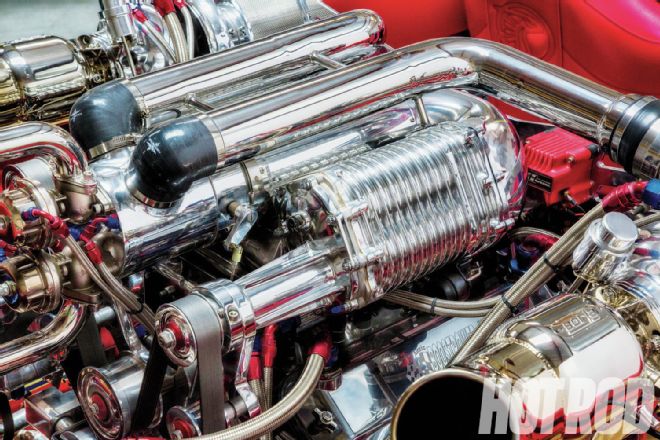
HOT ROD has a long history of documenting boats going fast on liquid racetracks, so we weren’t surprised to find this dual-blower, twin-turbo engine between the stringers of a 21-foot Schiada River Cruiser. As the son of a military man, Alexi Sahagian learned a lot about compound-supercharged engines from his dad who worked with Detroit Diesels during World War II. That knowledge was passed on to Alexi, who made a clay model of this quad-blown beast when he was just a kid.
Decades later, Alexi’s shop, Boostpower USA Marine, brought his billet-aluminum vision to life by engineering and machining many of the parts used to assemble this 2,400hp engine. Boostpower’s clientele routinely requests reliable, supercharged engines to push large offshore-style powerboats across Big Blue at speeds that would spook any land lover. The punishment these engines endure during extended blasts over the water demands the best components money can buy, and those same parts are found inside this $159,000 bullet.
 Alexi Sahagian’s quad-blown engine is based on a Donovan billet-aluminum big-block Chevy architecture with an 11.625-inch deck height, 4.650-inch-diameter bores, and 5.000-inch bore spacing. It’s stuffed with an LA Enterprises crank with a 4.750-inch stroke, 6.700-inch-long Oliver rods, custom CP pistons, and tool-steel wristpins. It’s topped with 18-degree CNC-ported Brodix BB3 cast-aluminum heads, which Alexi says flow 500 cfm through the intake ports at just 0.700-inch valve lift. The block features piston oilers, splayed main-bearing-cap bolts, and enough meat around the cylinders to keep the liners round even with 40 psi of boost.
Alexi Sahagian’s quad-blown engine is based on a Donovan billet-aluminum big-block Chevy architecture with an 11.625-inch deck height, 4.650-inch-diameter bores, and 5.000-inch bore spacing. It’s stuffed with an LA Enterprises crank with a 4.750-inch stroke, 6.700-inch-long Oliver rods, custom CP pistons, and tool-steel wristpins. It’s topped with 18-degree CNC-ported Brodix BB3 cast-aluminum heads, which Alexi says flow 500 cfm through the intake ports at just 0.700-inch valve lift. The block features piston oilers, splayed main-bearing-cap bolts, and enough meat around the cylinders to keep the liners round even with 40 psi of boost.
Compound supercharging is where two air-compressing devices are mounted in series. On this engine, the twin turbos can compress the air leading into the twin superchargers. By themselves, turbos and superchargers each have their limitations. Turbos offer great peak power, but even with the latest compressor wheels and housing designs there is lag time before maximum boost is created in the intake. With a beltdriven supercharger, instant torque is there the moment you mash the gas pedal—but power upstairs doesn’t rival that of a turbo.
 Garrett GT-42 turbos with Gentry water-jacketed housings blow into Boostpower B2 112ci superchargers. As of 2011, in California every new marine engine must be emissions compliant, so Borla created these shorty multicore marine mufflers with a catalyst inside.
Garrett GT-42 turbos with Gentry water-jacketed housings blow into Boostpower B2 112ci superchargers. As of 2011, in California every new marine engine must be emissions compliant, so Borla created these shorty multicore marine mufflers with a catalyst inside.
Add electronic fuel injection and an ECM that can regulate the amount of boost delivered to the intake manifold by the compound system, and you have unparalleled flexibility in power production with various fuels. Alexi’s 87-octane tune-up has the blower bypass valve bleeding boost, so there’s only 7 psi in the manifold and that results in 985 hp. If there’s 91 octane in the tank, the valve stays shut and 11 psi yields 1,225 hp—and that’s without the turbos adding any boost. Fill the tank with 100-octane fuel, and the boost control locks in 18 psi with the aid of the turbos for 1,625 hp. Up to 40 psi of boost can be safely achieved using a mix of 114-octane fuel and methanol.
Designing a system where a turbocharger feeds a beltdriven supercharger is one answer to creating maximum power in every part of the curve. Packaging the system, especially in pairs, is the challenge. Here’s a look at how Alexi did just that.
 The packaging is complex. The valve covers are a quick-release design that keeps Alexi from throwing tools around the shop when it’s time to set the valve lash on the Jesel shaft-mounted rockers. The cam is a billet grind with 0.740-inch lift and just 260 degrees of duration. The intake is a custom V-floor Boostpower part with an integrated 4-inch-thick intercooler core. An EFI Technology X3 ECM offers multiple maps, flex fuel capability, and variable boost control for bypassing the superchargers once the turbos are spooled up. Eight 125-lb-hr Delphi low-impedance injectors provide fuel to the engine, which idles like a kitten but becomes a hellion once the throttle is pinned wide open. Peak power occurs at just 5,500 rpm. There are untold hours in the front accessory drive system, but we’ve seen videos of this thing ripping across the water for miles at a time, so it obviously works.
The packaging is complex. The valve covers are a quick-release design that keeps Alexi from throwing tools around the shop when it’s time to set the valve lash on the Jesel shaft-mounted rockers. The cam is a billet grind with 0.740-inch lift and just 260 degrees of duration. The intake is a custom V-floor Boostpower part with an integrated 4-inch-thick intercooler core. An EFI Technology X3 ECM offers multiple maps, flex fuel capability, and variable boost control for bypassing the superchargers once the turbos are spooled up. Eight 125-lb-hr Delphi low-impedance injectors provide fuel to the engine, which idles like a kitten but becomes a hellion once the throttle is pinned wide open. Peak power occurs at just 5,500 rpm. There are untold hours in the front accessory drive system, but we’ve seen videos of this thing ripping across the water for miles at a time, so it obviously works.